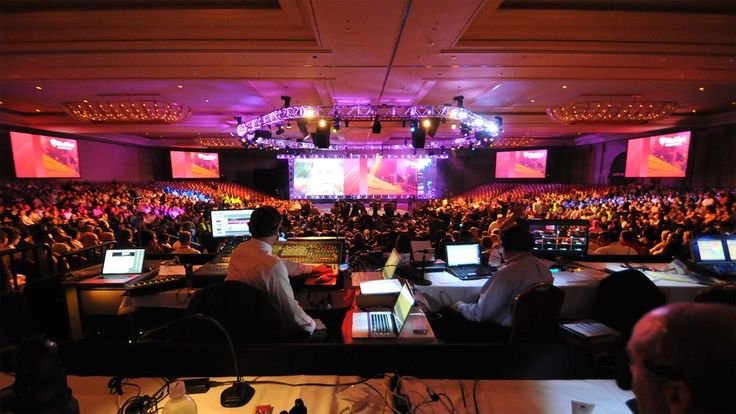Complete Guide to Live Event Planning
Discover key steps for companies' live event production planning, including setting goals, budgeting, choosing a venue, and event day prep. Learn more.

Planning a live event is fun but can also be overwhelming due to unexpected issues, tight deadlines, varied attendee needs, and logistical complexity. However, some steps and considerations of a live event production company will help you organize a successful live event. These steps include defining clear goals and creating a budget. Selecting the right date and venue is essential, starting with a reliable team and then marketing the event. Finally, preparation on the event day and follow-up actions ensure an enjoyable experience for attendees.
Step-by-Step Guide to Live Event Production
Here are the steps businesses should consider:
Step 1: Define Your Goals
Define your goals clearly before you begin planning. Having clear goals will help you make better decisions.
Questions to Consider
-
What is the event’s primary objective?
-
Who is your target audience?
-
What message do you want to communicate?
-
Is the event meant to raise funds, educate, celebrate, or entertain?
Step 2: Create a Budget
After setting your goals, create a budget—one of the most important aspects of event planning. It will keep you on track with your spending so that you do not overdo it.
Key Elements of a Budget
-
Venue rental
-
Catering and food services
-
Audio-visual equipment
-
Staffing and security
-
Marketing and promotional materials
-
Decorations and supplies
-
Contingency funds for unknown expenses
Always account for all expenses and include a contingency fund for unexpected costs.
Step 3: Choose a Date and Venue
Choose a date and venue that fit the occasion just right. Ensure the event date does not conflict with other major local events.
Tips for Choosing a Venue
-
Capacity: Ensure that your preferred venue has ample space for all the guests to attend.
-
Facilities: Ensure the venue has restrooms and parking and is accessible to all guests.
-
Location: Select a place that is readily accessible to your audience.
-
Atmosphere: Choose a venue with an ambiance that enhances your event’s theme.
Step 4: Plan the Agenda
Every successful live event production calls for an agenda. Agendas vary depending on the event—formal for conferences, flexible for social gatherings. With a well-structured agenda, everything goes smoothly.
Creating an Agenda
-
Identify the major activities, such as speeches, workshops, or performances.
-
Assign time slots for each activity.
-
Designate speakers, presenters, or hosts for different segments.
-
Include breaks for networking and refreshments.
Step 5: Assemble Your Team
No matter how small the event, doing everything alone can overwhelm you. So, gather a live event production team to help you with different aspects of the production.
Roles to Consider
Event Coordinator: Responsible for all aspects of the event.
Marketing Coordinator: Promotes the event and handles social media.
Technical Team: Oversees audio-visual equipment.
On-Site Staff: Assists guests on the day of the event.
Assign clear roles and responsibilities to each team member for smooth coordination.
Step 6: Promote Your Event
Once your event details are finalized, it's time to start promotion. Promotion is the lifeblood of attracting attendees.
Promotion Strategies
-
Build an attractive event website or landing page.
-
Use social media, local media, and blogs to reach your audience.
-
Send emails to those in your email list.
-
Work with influencers and local businesses to spread the word around.
Promotional materials should reflect the event’s theme and message.
Step 7: Prepare for the Day of the Event
Preparation is crucial to keeping everything on track during the event.
Actions to Take
-
Arrive early enough to oversee setting up and to check all the equipment.
-
You and your team should do a "run-through" to ensure everyone knows what to do.
-
List the names and contacts of all members and vendors on the team so it's easy to communicate.
-
Distribute copies of the agenda and timeline.
-
You might face some issues, but remaining cool will help you face those issues.
Step 8: Follow Up After the Event
You will have time for reflection and assessment after the event.
Follow-Up Actions:
-
Take comments from attendees through a feedback survey or just an informal gathering.
-
Assess your budget to identify strengths and areas for improvement.
-
Plan your future events from your experience.
-
Staying in contact with the attendees after the live event is an excellent way to build relationships.
Challenges Businesses Face During Live Event Production Planning
Most businesses face the following challenges:
-
Budget Constraints: High cost of production but low budget.
-
Technical Issues: Internet and equipment malfunction.
-
Logistical Complexities: Finding efficient venue suppliers and schedules.
-
Audience Engagement: Keeping the audience interested and interactive during the event is difficult.
-
Unpredictable Factors: Inclement weather, cancellation at the last minute.
Conclusion
A successful event production requires careful consideration of various elements, including clear goal setting, budgeting, and team assembly. Businesses must also navigate budget constraints, technical issues, and logistical complexities. Additionally, maintaining audience engagement and adapting to unpredictable factors can prove difficult. By focusing on these steps taken by a live event production planning company, businesses can enhance their event production and create memorable experiences for attendees.
What's Your Reaction?

















.jpg)